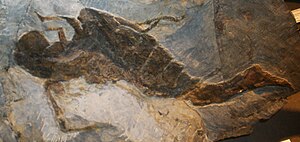Jaekelopterus
| Jaekelopterus | ||||||||||||
|---|---|---|---|---|---|---|---|---|---|---|---|---|

Fossil of Jaekelopterus rhenaniae |
||||||||||||
| Temporal occurrence | ||||||||||||
| Pragium to Emsium ( Lower Devonian ) | ||||||||||||
| 410 to 397 million years | ||||||||||||
| Locations | ||||||||||||
|
||||||||||||
| Systematics | ||||||||||||
|
||||||||||||
| Scientific name | ||||||||||||
| Jaekelopterus | ||||||||||||
| Waterston , 1964 | ||||||||||||
| species | ||||||||||||
|
||||||||||||
Jaekelopterus is a genus of the Eurypterida (dt. Sea scorpions ) thatlivedin the Lower Devonian more than 397 million years ago. The prey animals mainly included tank fish . The type species Jaekelopterus rhenaniae was described by Otto Jaekel in 1914as Pterygotus rhenaniae (about "Rhenish Flosser"); When Waterston (1964) placed this species in its own genus, he named it after the first person to describe it, Jaekelopterus .
After the discovery of a 46 cm long fossil jaw claw ( Chelicere ) of Jaekelopterus rhenaniae by the paleontologist Markus Poschmann from the Emsium ( Lower Devonian ) of the Willwerath fossil deposit near Prüm , it can be assumed that these animals were about 2.50 meters tall and thus the largest known giant scorpions are. The jaw claw is exhibited together with other fossils from the same site in the Natural History Museum in Mainz .
Web links
Individual evidence
- ↑ M. Alan Kazlev: The Trace of Life on Earth. In: PALAEOS. Retrieved November 24, 2007 .
- ^ CD Waterston: Observations on pterygotid eurypterids . In: Transactions of the Royal Society of Edinburgh . tape 66 , 1964, pp. 9-33 . quoted from Samuel J. Ciurca Jr., O. Erik Tetlie: Pterygotids (Chelicerata; Eurypterida) from the Silurian Vernon Formation of New York. Journal of Paleontology, Jul 2007, p. 3
- ↑ Simon J. Braddy, Markus Poschmann, O. Erik Tetlie: Giant claw reveals the largest ever arthropod . In: Biology Letters . tape 4 , no. 1 , 2008, p. 106-109 , doi : 10.1098 / rsbl.2007.0491 .